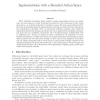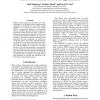1100 search results - page 174 / 220 » Exertion in networked games |
ECCV
2004
Springer
14 years 9 months ago
2004
Springer
We present a vision based, adaptive, decision theoretic model of human facial displays in interactions. The model is a partially observable Markov decision process, or POMDP. A POM...
GECCO
2007
Springer
14 years 1 months ago
2007
Springer
Adaptive representations allow evolution to explore the space of phenotypes by choosing the most suitable set of genotypic parameters. Although such an approach is believed to be ...
SIGECOM
2006
ACM
14 years 1 months ago
2006
ACM
While traditional mechanism design typically assumes isomorphism between the agents’ type- and action spaces, in many situations the agents face strict restrictions on their act...
DSRT
2009
IEEE
13 years 11 months ago
2009
IEEE
—Interest management is essential for real-time large-scale distributed virtual environments (DVEs) which seeks to filter irrelevant messages on the network. Many existing inter...
AAAI
2010
13 years 9 months ago
2010
Modern complex games and simulations pose many challenges for an intelligent agent, including partial observability, continuous time and effects, hostile opponents, and exogenous ...


